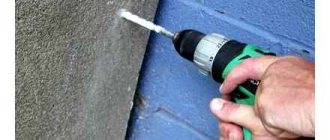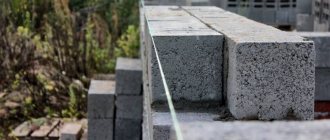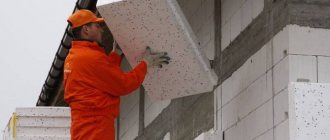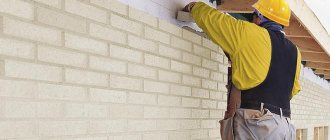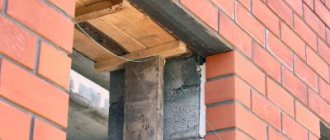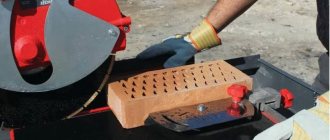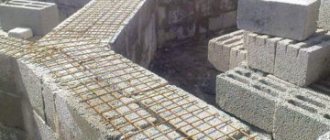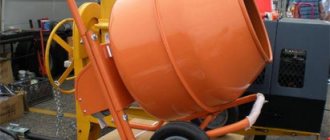When reconstructing or renovating houses, it is often necessary to demolish old walls. Removing brick walls is a process that requires some knowledge. Work on redevelopment of any room involves dismantling the brickwork.
You can dismantle a brick wall yourself using a jackhammer, chisel and hammer drill.
There are the following types of walls:
- Bearers.
- Basic (partitions).
Bearings are supports for the ceiling. It is prohibited to demolish a brick wall yourself. If you neglect this rule, the building may collapse. Construction specialists can determine load-bearing walls.
The main ones are partitions. They are usually made of brick. Do-it-yourself dismantling of brick partitions in an apartment is permitted. It will not lead to the destruction of the building, since the load will not be redistributed. But it’s still better to entrust the dismantling of walls to specialists.
How can you disassemble brickwork without damaging the brick?
Sometimes during construction the question arises of how to disassemble brickwork without damaging the brick. Redevelopment of an apartment and its renovation are quite important measures designed to create additional comfort and coziness, as well as significantly improve aesthetic qualities. In some cases, carrying out such actions may require demolishing any of the walls or changing its shape.
Careful dismantling of the brickwork will help preserve the brick for future use.
Do you want to dismantle interior partitions? It’s easy to agree on redevelopment
Order a project . Technical and design documentation can be obtained from a company with SRO approval; another form of document submission is not even considered.
Obtaining permission for redevelopment . The request is made either to the MFC or to the government agency that approves the redevelopment of the apartment in your city.
Standard package of documents:
- an application in the form of the MFC or a government agency confirming the authorization for the demolition of interior partitions;
- redevelopment project drawn up by a company with access to SRO;
- documents confirming ownership or an extract from the Unified State Register.
Standard consideration of an application for redevelopment is 30-50 days.
Manual dismantling of brick partition walls
This work can be done manually if the brick wall was laid on a cement or lime mixture. In addition, the binder must have a low concentration. If these conditions are met, such a wall can be dismantled with a crowbar, pickaxe or hammer. In this case, you will be able to obtain bricks suitable for subsequent use, but you will need to clean off the binding solution from them.
First of all, hammer the wedges into the horizontal and vertical sections of the wall with a hammer - this will lead to the appearance of cracks and gradual destruction of the working surface.
If at one time the brick wall was laid on a stronger mortar, more effort will be required to dismantle it. We are talking about the use of pneumatic or electric tools.
To perform disassembly manually, you can use a metal wedge driven into the inside of the wall with a hammer. To make the wall collapse, hit it with a jackhammer.
Brick vaults must be disassembled manually, starting dismantling work from the key areas and gradually moving towards the heel. In the case of sail vaults, use the circular method. To prevent the destruction of the vault, prepare the formwork in advance.
Which GOSTs and SNIPs apply to the demolition of load-bearing walls?
The norms and rules for the demolition of load-bearing walls are developed in accordance with the Federal Law of the Russian Federation. The following must be observed:
- N 384-F3 “Technical regulations on the safety of buildings and structures”, dated December 27, 2002;
- N 184-FZ “On technical regulation”, dated 2910.04;
- N 190-FZ “Town Planning Code of the Russian Federation” dated February 16, 2008;
- N 87 “On the composition of sections of project documentation and requirements for their content.”
The system of occupational safety standards is regulated by GOSTs:
- 1.004-91 fire safety requirements;
- 1.012-90 vibration safety requirements;
- 1.046-85 requirements for lighting of construction sites;
- 2.003-91 production equipment standards;
- 2.010-75 standards for manual and pneumatic machines;
- 2.013.0-91 electric hand machines;
- 3.002-75 production processes;
- 31937-2011 inspection of the technical condition of the building;
Tools to carry out work without damaging the brick
These tools will help you break the wall of a brick house without damaging the bricks.
A pickaxe may be needed to carry out the work.
- pick;
- chisel;
- sledgehammer;
- jackhammer and regular hammer;
- metal wedges;
- perforator;
- gloves;
- protective glasses.
It’s not enough to just stock up on these tools; you also need to know how to use them. Removing the lining does not require the use of the entire set of devices, but depending on its type, one or another equipment may be needed. A hammer drill and a jackhammer can be used to break off thick brick walls. The relay is removed with a chisel and sledgehammer. They start working from the top row, without worrying about the safety of the material, and work their way down.
A chisel and metal wedges help dismantle each individual brick without disturbing its integrity. To do this, it is placed against the seam of the wall and hit with a hammer. By driving wedges into horizontal and vertical joints, you can dismantle walls with durable cement mortar. This work is best done with 4 hands. Thick masonry is made from 2 layers. It is advisable to leave the last layer of masonry in the form of a threshold at the joint. This will simplify finishing and allow you to distribute the space into 2 zones.
Are special permits required?
Some activities that involve reconstruction require the issuance of permits. This list includes:
- association of several apartments;
- joining the attic;
- arrangement of an opening for a door block in a load-bearing wall;
- connection of a room and a loggia;
- kitchen niche equipment.
The housing inspection also legalizes other changes if the main structures are violated. Before carrying out dismantling work, it is necessary to collect all documents and issue a permit, and obtain the consent of residents living in the neighborhood.
When obtaining permission to dismantle walls, certain factors are taken into account:
- the number of floors in the building and the floor where your apartment is located;
- year of construction of the building;
- building material used for the construction of internal and external walls and ceilings;
- quality condition of the foundation;
- type of wall planned for disassembly.
Dismantling of load-bearing walls is rarely performed, because as a result, the load on the base of the building increases and the foundation is subject to destructive processes.
Dismantling instructions: how to carefully dismantle brickwork
When planning how to dismantle a brick wall, first remove the floor and ceiling plinths. Next, remove the coating - wallpaper, paint, plaster - to the base surface of the structure.
To preserve building materials for further use in the construction of other objects, bricks are dismantled as carefully and accurately as possible. However, this is only possible if a lime or cement mixture with a low concentration of binder was used during the construction of the wall. This structure is not difficult to dismantle using a regular set of chisels and hammer. If the material is laid on a stronger mortar, you will have to use an electric or pneumatic tool to dismantle the masonry. In this case, a significant part of the stones is deformed along with the building mixture.
How to optimize the work so that most of the brick remains intact and suitable for reuse:
- using an electric drill, only the seams are destroyed, which allows you to then carefully knock out the stones and remove them;
- To dismantle the masonry, wedges are driven in along the horizontal and vertical seams. After cracks appear, they begin to carefully knock out each stone, avoiding deformation of the corners.
To ensure that most of the brick remains intact and suitable for reuse, only the seams are destroyed using an electric drill.
In any case, dismantling a brick wall with a strong mortar will require a lot of effort.
Stages of dismantling a wall
- Work begins by knocking out the top row of bricks at the junction of the partition and the ceiling. Insert a chisel into the first seam and strike with a hammer, destroying the joint. As cracks form in the mortar, they continue to move further, working horizontally.
- Next, take out the bricks of the top row, which are completely separated from the masonry. Those specimens that are stuck are knocked out with a hammer or crowbar. The stones are then lowered down through specially built chutes. Whole elements are immediately stored separately, and broken elements are collected in another pile. If necessary, immediately clear the stones from the mortar using the sharp end of a pick.
- In a similar way, all subsequent rows are dismantled, knocking out and removing 2-3 stones. It is worth remembering that simultaneous demolition of several rows of masonry is not allowed in order to avoid deformation of a large number of elements.
- The bottom row of masonry is usually embedded in a screed. To remove bricks without deforming the floor structure, you should cut a groove along the wall line and carefully knock out the remaining stones.
No. 4. How to remove tiles from drywall?
Many specialists do not like to bother with dismantling tiles, and as soon as they hear that the tiles are glued to drywall, they often refuse. The fact is that the glue literally eats into the drywall, so it can be removed along with the tiles. However, it is possible to separate the tiles from the wall. But no one can give an accurate forecast of what drywall will look like after such an execution. No one undertakes to guarantee the integrity of at least some part of the tile.
If the tile was laid several days ago, then it is still possible to remove it without much damage to the surface and the tile itself. In other cases you will have to suffer. The procedure is similar to the classic method:
- preparation of seams;
- First, you can dismantle one tile in the top row so that it is convenient for you to work. A hammer and a spatula/chisel/chisel/chisel will come to the rescue - everything is as described above;
- the remaining tiles are removed one by one with the same set of tools;
- don’t be alarmed if the tiles fall off with part of the drywall;
- It is almost impossible to remove tile adhesive from drywall. If this is important, then remove the glue gradually with a grinder, just work very carefully;
- when the work is completed, assess the damage;
- if the partition has minor damage, then the pits and glue residues can be hidden under a layer of putty. After it dries, it will be possible to install new tiles. If the tile is removed “with meat”, then a complete replacement of the partition may be necessary. You need to be prepared for this right away.
Technology and manual breaking process
Before starting to dismantle the walls, determine its type: load-bearing or partition wall.
Any reconstruction of walls in apartment buildings is coordinated with its balance holder. Once permission is given to remove the wall structure, technology is developed to strengthen the remaining walls with braces to take the weight of the ceiling.
List of preparatory activities that the contractor needs to complete before carrying out the work:
Furniture and property not related to the dismantling are removed from the premises.- Anything that cannot be taken out is carefully covered with film.
- Protect window packages from accidental impact from fragments.
- They completely de-energize power lines and block other utility networks.
- Remove door panels, baseboards and cladding.
- Remove the plaster and remove the wallpaper.
- Collect garbage and carry it out.
- Cover the floors with durable material: sheet steel, chipboard or plywood.
Removing internal
For this type of work, manual disassembly is used in order to carry out the work with maximum precision and preserve the blocks for subsequent construction. At the same time, you can count on manual dismantling for walls made of no more than one brick.
Manual dismantling algorithm:
- First, tap the wall to identify voids and weak seams.
- Insert a chisel into the first top seam and strike it a couple of times with a sledgehammer.
- The resulting crack is widened.
- They dismantle stones that have separated from the masonry. Carefully remove the blocks and set them aside so that they do not interfere with future disassembly.
- Stuck bricks are knocked out with a sledgehammer and a crowbar.
- In a similar way, 2 stones are knocked out and removed. Dropping huge pieces of the wall is not allowed both from the point of view of the rules for safe work and in order to save more bricks.
- Break the bottom row of blocks embedded in the screed.
- In order not to spoil the screed, make a groove in the wall and only then remove the blocks.
- The resulting whole and half stones are cleaned of the mortar and stored for subsequent use: the construction of garages, pavilions or other auxiliary premises in the local area.
How to break external ones?
External walls are mainly dismantled using mechanical means .
Mechanical dismantling of brick wall structures is accepted in cases of significant volumes, when the building is completely dismantled and when it is not intended to keep the blocks intact.
What you need to remember if you are planning to break a wall in your apartment
When dismantling walls in an apartment, it is very important to know that inside the walls there may be:
- electric wires;
- steel reinforcement;
- water pipes.
Let's look at them in order.
Hidden wiring
It is recommended to examine the demolished wall using a non-contact probe (see Video tutorial. Working with a hidden wiring detector). If you see wires while demolishing a wall, try to tap the concrete around the wires carefully! Do not allow a situation where a heavy piece of concrete wall hangs on the wire as a result of your chiselling.
Hidden steel reinforcement
Concrete walls are usually not made of just concrete. If you have a panel house, then the walls consist of reinforced concrete blocks, which means that steel reinforcement runs inside the walls. The only reliable and quick way to cut steel reinforcement is to cut it using a grinder. You need to put a metal disc on the grinder and cut off the reinforcement. All other methods are ineffective and very slow.
Hidden water pipes
When renovating a bathroom, the plumbing is often hidden in the walls under the tiles. If you moved into an apartment that had previously been renovated, then there is a possibility that the previous residents hid the pipes in the concrete wall. Therefore, in any case, disassemble the wall carefully. And if you come across just such a situation, then think it over carefully. Here, in addition to the wall, you will have to dismantle the old pipes, while turning off the water using ball valves on the risers.
Yes, I almost forgot. Prepare more construction bags! After all, when you start breaking down a wall, you will immediately have pieces of concrete or brick, and in large quantities! They immediately need to be put somewhere and taken out. The most convenient thing is construction bags, which are sold in any construction hypermarket. Just don’t forget to read what to do with construction waste.
That's all, dear readers. Today we learned how to break a wall and what technologies and tools can be used to do this.
Wall dismantling technology
Drywall and foam blocks are the most common materials for partitions, and their dismantling is not difficult: the texture and density of the structures facilitate their quick disassembly.
From foam block
This is a universal building material that can be used both in the construction of apartment buildings and in the construction of private houses. The blocks are quickly installed and exhibit excellent sound and heat insulation properties. Therefore, it is customary to assemble internal partitions from blocks, which must be dismantled; a little less often they are used in the construction of external walls.
The raw material for foam blocks is cellular concrete; it is light in weight, can be easily sawed and cut, and holes can be drilled in it using an electric or hand drill. You also need to take into account that special glue is used to connect products, and metal reinforcement is laid to enhance strength.
Taking into account the specified characteristics of foam blocks, it is necessary to prepare the following tools for work:
- sledgehammer,
- grinder,
- hammer,
- saw.
First, the top decorative layer (in particular, putty, plaster) is removed, then individual pieces of material are knocked out using a sledgehammer or hammer. In general, dismantling does not create difficulties; a lot of dust does not form during work.
After all manipulations are completed, the waste is taken to a landfill.
From plasterboard
In apartment buildings built at the end of the last century, partitions based on plasterboard are common. This universal material is easy to break; the main thing is to take care of comfortable working conditions.
The preparatory stage boils down to the following activities:
- when destroyed, drywall creates a lot of dirt and dust, so it is important to vacate the premises in advance and carefully pack all furniture that cannot be removed in film;
- in the process of demolishing this type of partition, the floor will not be damaged, but it will have to deal with all the dirt that is generated. To make subsequent cleaning easier, it is advisable to cover it with protective material or thick oilcloth;
- from the wall that is planned to be eliminated, it is necessary to remove not only decorative elements, but also the door frame and electrical wiring.
Demolition of a structure can be carried out in several ways, depending on its type, since the composition may include plaster slabs or a metal frame. Here are 3 convenient dismantling methods:
- If the partition is assembled from sheet cladding, first of all you need to find the screws and carefully remove everything (a magnet will help in the search). Next, remove the casing and begin disassembling the frame. The advantage of this method is the possibility of reusing the lathing and sheets to build a partition in another place. But there is also a drawback: in order to maintain the integrity of the materials, you will have to spend a lot of time and effort.
- The easier impact method is based on the use of a sledgehammer or hammer. In this case, the material is completely destroyed and taken to a landfill.
- If the task is to make a smooth opening in an existing wall, you should use a diamond cutter. This expensive equipment requires certain working skills.
In the latter case, it is important not only to rid the structure of wiring, it is advisable to draw up a plan for the future interior in advance in order to accurately mark and maintain proportions.
Three ways to change the look of a brick wall
Brickwork can become the highlight of an interior if you work on it a little. Among the options for its transformation, the most popular are cladding, painting and artificial aging. The choice will depend on the initial quality of the surface and the style in which the entire room is decorated.
Cladding with brick panels
Often, even after professional repairs, an old wall looks unsightly, although there are no complaints about its strength. In the case when you don’t want to lose the texture, but you couldn’t bring the surface into decent shape, you can cover it with decorative panels that imitate masonry.
This can be base brick siding, panels made of polyvinyl chloride, MDF or gypsum, as well as clinker tiles or thin facing bricks. And thermal panels are perfect for finishing and insulating external walls.
The installation method for these materials is different:
- Wall panels are attached to the frame;
- The facing tiles are glued to the surface using glue.
Flexible clinker: installation details
It is important to follow the installation technology and do everything correctly and consistently. Do not use cheap glue that is not suitable for the job. As a result, the coating will last much longer.
Before using the material directly, you need to prepare the surface:
- Clean from dirt, dust, old paint, whitewash;
- Align;
- Plaster;
- Putty;
- Prime;
- Insulate;
- Create a background.
When a façade is decorated with Euroclicker, it must be insulated with mineral wool. The material is laid on a substrate. For this purpose, you can use glass fiber fixed on top of the insulation or marble chips. The sheet or mesh of the flexible clicker itself is coated with glue on the inside and fixed to the surface.
The material bends easily in any direction and emphasizes corners and arched elements well. If necessary, you can:
- Use various other decorative elements;
- Emphasize the chosen interior style with something bright;
- Create visual zoning of space due to the contrast of the material used.
Thus, if brickwork is an expensive pleasure, then you can get by with its imitation. Flexible clinker can successfully fulfill this role. The reviews about it are amazing. The material is really worth paying attention to, to take a closer look at it and decide what surface to decorate with it. Simplicity and ease of installation will allow you to carry out all the work yourself, delight the eye for many years, and evoke the envious gaze of neighbors and guests.
Preparing to dismantle walls
To dismantle a brick wall you will need: a hammer drill, a drill, a jigsaw and an electric screwdriver.
Dismantling work should be carried out with the obligatory use of protective equipment. When dismantling walls, fine dust is generated, which can cause serious harm to health, so it is necessary to use special clothing and safety glasses. It is also advisable to wear a respirator.
In order to dismantle a brick wall, you can resort to the help of professionals or do it yourself.
The cost of dismantling brick walls will depend on some features of the building and its size.
If you turn to professionals for such work, during the demolition process they will use power tools and various devices for manually removing the binder from bricks.
Before dismantling begins, preparation must be made depending on the specific working conditions. For example, sometimes it is necessary to dismantle only one wall in the house, that is, a partition.
It should be noted that bricks are quite heavy and if they fall on the floor, its coating may be damaged. In this case, it is necessary to create a protective layer on the floor (old blankets and unnecessary rags will do). Furniture must be removed from the premises.
In order to quickly dismantle a brick wall, the jackhammer should be aimed at the joints of the bricks.
Electrical wiring must be removed in advance. To do this, turn off the power completely, otherwise there is a risk that during operation the wires will be damaged by brick fragments, tools will land on a bare wire, a short circuit will occur, or people will be injured.
It is useful to spray the wall with water from time to time; it produces more dirt, but wet dust does not get inside when you breathe, and less harm is done to your health. Workers carrying out dismantling should definitely wear safety glasses.
First, from a brick building intended for dismantling, it is necessary to completely remove the window and door structures and remove the plaster. Dismantling begins with knocking out several elements at the joints of the ceiling and partition. The strength of the connection of bricks can be broken by strong blows, for which a sledgehammer is most often used. You shouldn’t immediately dismantle the walls in large pieces; it’s better to separate several bricks if possible.
Return to contents
Coloring
If you want to make a hint of a brick wall rather than completely reproduce it, you can limit yourself to just paint. In this case, the wall is painted over with base paint (this will be the color of the seams between the bricks), then masking tape is pasted in the shape of the brickwork and the resulting “bricks” are painted over with a sponge. To better reproduce the texture, it is better to take several shades. Let it dry, remove the tape and admire the result. The method is cheap, but more ironic than serious.

